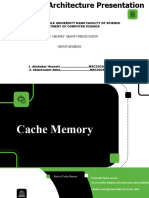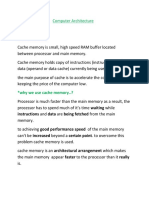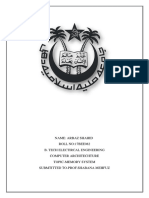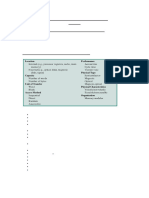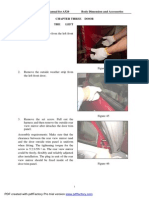0 ratings0% found this document useful (0 votes)
5 viewsModule 3 Memory Unit
Uploaded by
deepthikCopyright
© © All Rights Reserved
Available Formats
Download as PPTX, PDF, TXT or read online on Scribd
0 ratings0% found this document useful (0 votes)
5 viewsModule 3 Memory Unit
Uploaded by
deepthikCopyright
© © All Rights Reserved
Available Formats
Download as PPTX, PDF, TXT or read online on Scribd
You are on page 1/ 19
Memory Unit
Speed, Size, and Cost
• An ideal memory would be fast, large, and inexpensive.
• A very fast memory can be implemented if SRAM chips are
used. But these are expensive.
• The alternative is to use Dynamic RAM chips, are much less
expensive. But such memories are significantly slower.
• A secondary storage, mainly magnetic disks, to implement
large memory spaces.
• Very large disks are available at a reasonable price, and they
are used extensively in computer systems.
• They are much slower than the semiconductor memory units.
• A huge amount of cost-effective storage can be provided by
magnetic disks.
• A large, yet affordable, main memory can be built with
dynamic RAM technology.
• All of these different types of memory units are employed
effectively in a computer.
• The entire computer memory can be viewed as the hierarchy.
• The fastest access is to data held in processor registers.
• Then the processor registers are at the top in terms of the
speed of access in the memory hierarchy.
• At the next level of the hierarchy is a relatively small amount
of memory that can be implemented directly on the processor
chip.
• This memory, called a processor cache, holds copies of
instructions and data stored in a much larger memory that is
provided externally.
• There are often two levels of caches.
• A primary cache is always located on the processor chip.
• This cache is small and referred to as level 1 (L1) cache.
• A larger, secondary cache is placed between the primary
cache and the rest of the memory.
• It is referred to as level 2 (L2) cache. It is usually implemented
using SRAM chips.
• Including a primary cache on the processor chip and using a
larger, off-chip, secondary cache is currently the most
common way of designing computers.
• It is possible not to have a cache on the processor chip at all.
• Also, it is possible to have both L1 and L2 caches on the
processor chip.
• The next level in the hierarchy is called the main memory.
• This large memory is implemented using dynamic memory
components, typically in the form of SIMMs, DIMMs, or
RIMMs.
• The main memory is much larger but significantly slower than
the cache memory.
• In a typical computer, the access time for the main memory is
about ten times longer than the access time for the L1 cache.
• Disk devices provide a huge amount of inexpensive storage.
• They are very slow compared to the semiconductor devices
used to implement the main memory.
Cache Memories
• The speed of the main memory is very low in comparison with
the speed of modern processors.
• For good performance, the processor cannot spend much of
its time waiting to access instructions and data in main
memory.
• Hence, it is important to devise a scheme that reduces the
time needed to access the necessary information.
• Since the speed of the main memory unit is limited by
electronic and packaging constraints, the solution must be
sought in a different architectural arrangement.
• An efficient solution is to use a fast cache memory which
essentially makes the main memory appear to the processor
to be faster than it really is.
• The effectiveness of the cache mechanism is based on a
property of computer programs called locality of reference.
• Analysis of programs shows that most of their execution time
is spent on routine in which many instructions are executed
repeatedly.
• These instructions may constitute a simple loop, nested loops,
or a few procedures that repeatedly during some time period,
and the remainder of the program is accessed relatively
infrequently. This is referred to as locality of reference.
• It manifests itself in two ways: temporal and spatial.
• The first means that a recently executed instruction is likely to
be executed again very soon.
• The spatial aspect means that instructions in close proximity
to a recently executed instruction are also likely to be
executed soon.
• If the active segments of a program can be placed in a fast
cache memory, then the total execution time can be reduced
significantly.
• The memory control circuitry is designed to take advantage of
the property of locality of reference.
• The temporal aspect of the locality of reference suggests that
whenever an information item is first needed, this item
should be brought into the cache where it will hopefully
remain until it is needed again.
• The spatial aspect suggests that instead of several items that
reside at adjacent addresses as well.
• The term block is used to refer to a set of contiguous address
locations of some size.
• Another term that is often used to refer to a cache block is
cache line.
• Consider the simple arrangement in fig 5.1.4.
• When a Read request is received from the processor, the
contents of a block of memory words containing the location
specified are transferred into the cache one word at a time.
• Subsequently, when the program references any of the
locations in this block, the desired contents are read directly
from the cache.
• Usually, the cache memory can store a reasonable number of
blocks at any given time, but this number is small compared
to the total number of blocks in the main memory.
• The correspondence between the main memory blocks and
those in the cache is specialized by a mapping function.
• When the cache is full and a memory word that is not in the
cache is referenced, the cache control hardware must decide
which block should be removed to create space for the new
block that contains the referenced word.
• The collection of rules for making this decision constitutes the
replacement algorithm.
• The processor does not need to know explicitly about the
existence of the cache.
• It simply issues Read and write requests using addresses that
refer to locations in the memory.
• The cache control circuitry determines whether the requested
word currently exists in the cache.
• If it does, the Read or Write operation is performed on the
appropriate cache location.
• In this case, a read or write hit is said to have occurred.
• In a read operation, the main memory is not involved.
• For a Write operation, the system can proceed in two ways.
• In the first technique, called the write-through protocol, the
cache location and the main memory location are updated
simultaneously.
• The second technique is to update only the cache location and
to mark it as updated with an associated flag bit, often called
the dirty or modified bit.
• The main memory location of the word id updated later, when
the block containing this marked word is to be removed from
the cache to make room for a new block.
• This technique is known as the write-back, or copy-back,
protocol.
• When the addressed word in a Read operation is not in the
cache, a read miss occurs.
• The block of words that contains the requested word is copied
from the main memory into the cache.
• After the entire block is loaded into the cache, the particular
word requested is forwarded to the processor.
• Alternatively, this word may be sent to the processor as soon
as it is read from the main memory.
• The latter approach, which is called load-through, or early
restart, reduces the processor’s waiting period somewhat, but
at the expense of more complex circuitry.
• During a Write operation, if the addressed word is not in the
cache, a write miss occurs.
• Then, if the write-through protocol is used, the information is
written directly into the main memory.
• In the case of the write-back protocol, the block containing
the addressed word is first brought into the cache, and then
the desired word in the cache is overwritten with the new
information.
You might also like
- Cache Memory: Computer Architecture Unit-1No ratings yetCache Memory: Computer Architecture Unit-154 pages
- Memory (Unit-3) : 6.1 Main Memory, Secondary Memory and Backup MemoryNo ratings yetMemory (Unit-3) : 6.1 Main Memory, Secondary Memory and Backup Memory8 pages
- Memory Sub-System: CT101 - Computing SystemsNo ratings yetMemory Sub-System: CT101 - Computing Systems46 pages
- Cache Memory: William Stallings, Computer Organization and Architecture, 9 EditionNo ratings yetCache Memory: William Stallings, Computer Organization and Architecture, 9 Edition47 pages
- The University of Zambia in Conjuction With Zambia Ict CollegeNo ratings yetThe University of Zambia in Conjuction With Zambia Ict College12 pages
- Lecture 2.2.4 (Associative Memory, Cache Memory and Its Design Issues)No ratings yetLecture 2.2.4 (Associative Memory, Cache Memory and Its Design Issues)54 pages
- William Stallings Computer Organization and Architecture 9 EditionNo ratings yetWilliam Stallings Computer Organization and Architecture 9 Edition46 pages
- 52-Cache Memory_ Principles, Cache Memory Management Techniques-28!02!2025No ratings yet52-Cache Memory_ Principles, Cache Memory Management Techniques-28!02!202511 pages
- William Stallings Computer Organization and Architecture 9 EditionNo ratings yetWilliam Stallings Computer Organization and Architecture 9 Edition46 pages
- Memory Organization: Registers, Cache, Main Memory, Magnetic Discs, and Magnetic TapesNo ratings yetMemory Organization: Registers, Cache, Main Memory, Magnetic Discs, and Magnetic Tapes15 pages
- SAS Programming Guidelines Interview Questions You'll Most Likely Be AskedFrom EverandSAS Programming Guidelines Interview Questions You'll Most Likely Be AskedNo ratings yet
- LPIC-3 Exam 306-300 Mastery: 500 Practice Questions on High Availability & Storage ClustersFrom EverandLPIC-3 Exam 306-300 Mastery: 500 Practice Questions on High Availability & Storage ClustersNo ratings yet
- Distributed Caching & Data Management: Mastering Redis, Memcached, And Apache Ignite CachingFrom EverandDistributed Caching & Data Management: Mastering Redis, Memcached, And Apache Ignite CachingNo ratings yet
- HPE ProLiant MicroServer Gen10 Plus Digital Data sheet-PSN1012241014USENNo ratings yetHPE ProLiant MicroServer Gen10 Plus Digital Data sheet-PSN1012241014USEN4 pages
- Guidelines For Review of MVS MVS Worksheet: ObjectiveNo ratings yetGuidelines For Review of MVS MVS Worksheet: Objective15 pages
- Sub Code & Name: Ec2207 Digital Electronics Lab Semester: Iii DATE: 29.10.12-31.10.12No ratings yetSub Code & Name: Ec2207 Digital Electronics Lab Semester: Iii DATE: 29.10.12-31.10.124 pages
- Digital Clock With PIC Micro - Orologio Digitale (Service Manual)No ratings yetDigital Clock With PIC Micro - Orologio Digitale (Service Manual)10 pages
- MANUAL IG - RS20 - RS30 - RS40 - Managed - 14 - 1209 - enNo ratings yetMANUAL IG - RS20 - RS30 - RS40 - Managed - 14 - 1209 - en62 pages
- ITCC in Riyadh Residential Complex J10-13300 01500-1 Construction Facilities and Temporary ControlsNo ratings yetITCC in Riyadh Residential Complex J10-13300 01500-1 Construction Facilities and Temporary Controls8 pages
- Fisher™ FIELDVUE™ DVC6200 SIS Digital Valve Controller100% (1)Fisher™ FIELDVUE™ DVC6200 SIS Digital Valve Controller116 pages
- Memory (Unit-3) : 6.1 Main Memory, Secondary Memory and Backup MemoryMemory (Unit-3) : 6.1 Main Memory, Secondary Memory and Backup Memory
- Cache Memory: William Stallings, Computer Organization and Architecture, 9 EditionCache Memory: William Stallings, Computer Organization and Architecture, 9 Edition
- The University of Zambia in Conjuction With Zambia Ict CollegeThe University of Zambia in Conjuction With Zambia Ict College
- Lecture 2.2.4 (Associative Memory, Cache Memory and Its Design Issues)Lecture 2.2.4 (Associative Memory, Cache Memory and Its Design Issues)
- William Stallings Computer Organization and Architecture 9 EditionWilliam Stallings Computer Organization and Architecture 9 Edition
- 52-Cache Memory_ Principles, Cache Memory Management Techniques-28!02!202552-Cache Memory_ Principles, Cache Memory Management Techniques-28!02!2025
- William Stallings Computer Organization and Architecture 9 EditionWilliam Stallings Computer Organization and Architecture 9 Edition
- Memory Organization: Registers, Cache, Main Memory, Magnetic Discs, and Magnetic TapesMemory Organization: Registers, Cache, Main Memory, Magnetic Discs, and Magnetic Tapes
- SAS Programming Guidelines Interview Questions You'll Most Likely Be AskedFrom EverandSAS Programming Guidelines Interview Questions You'll Most Likely Be Asked
- LPIC-3 Exam 306-300 Mastery: 500 Practice Questions on High Availability & Storage ClustersFrom EverandLPIC-3 Exam 306-300 Mastery: 500 Practice Questions on High Availability & Storage Clusters
- Distributed Caching & Data Management: Mastering Redis, Memcached, And Apache Ignite CachingFrom EverandDistributed Caching & Data Management: Mastering Redis, Memcached, And Apache Ignite Caching
- HPE ProLiant MicroServer Gen10 Plus Digital Data sheet-PSN1012241014USENHPE ProLiant MicroServer Gen10 Plus Digital Data sheet-PSN1012241014USEN
- Guidelines For Review of MVS MVS Worksheet: ObjectiveGuidelines For Review of MVS MVS Worksheet: Objective
- Sub Code & Name: Ec2207 Digital Electronics Lab Semester: Iii DATE: 29.10.12-31.10.12Sub Code & Name: Ec2207 Digital Electronics Lab Semester: Iii DATE: 29.10.12-31.10.12
- Digital Clock With PIC Micro - Orologio Digitale (Service Manual)Digital Clock With PIC Micro - Orologio Digitale (Service Manual)
- MANUAL IG - RS20 - RS30 - RS40 - Managed - 14 - 1209 - enMANUAL IG - RS20 - RS30 - RS40 - Managed - 14 - 1209 - en
- ITCC in Riyadh Residential Complex J10-13300 01500-1 Construction Facilities and Temporary ControlsITCC in Riyadh Residential Complex J10-13300 01500-1 Construction Facilities and Temporary Controls
- Fisher™ FIELDVUE™ DVC6200 SIS Digital Valve ControllerFisher™ FIELDVUE™ DVC6200 SIS Digital Valve Controller
